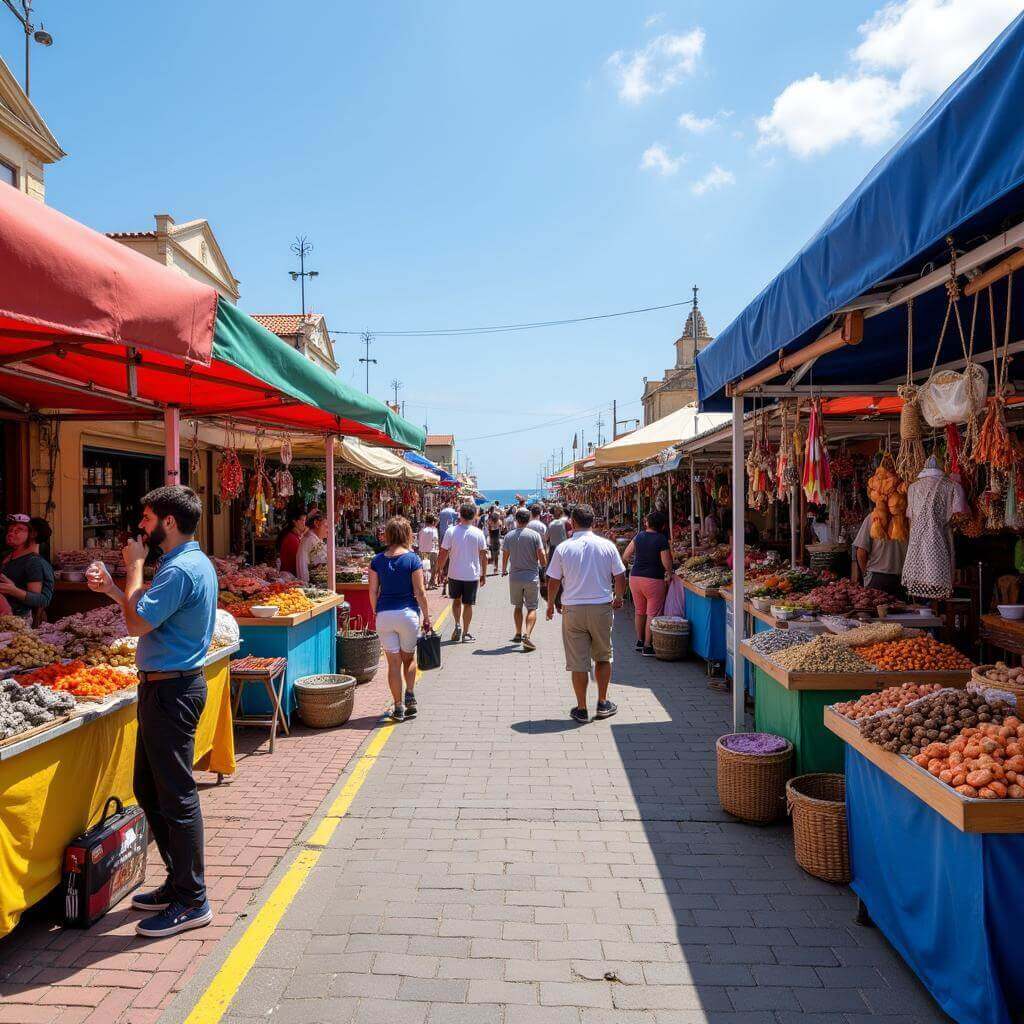Describing an outdoor market is a common topic in IELTS Speaking tests, particularly in Part 2. This theme allows candidates to showcase their vocabulary, descriptive skills, and ability to convey personal experiences. Given its relevance to everyday life and cultural experiences, it’s likely to remain a popular topic in future IELTS exams.
Part 1: Introduction and Interview
In Part 1, the examiner may ask general questions about markets. Here’s a sample question with a suggested answer:
Question: “Do you often go to markets?”
Answer (Band 7-8):
“Yes, I do enjoy visiting markets quite frequently. I find them to be vibrant hubs of local culture and commerce. There’s something captivating about the lively atmosphere and the opportunity to discover unique items or fresh produce. I try to visit our local farmers’ market at least once a month, as it’s a great way to support local businesses and find high-quality, seasonal ingredients for cooking.”
Part 2: Long Turn
Cue Card
Describe an outdoor market you visited recently
You should say:
- Where it was
- When you went there
- What you bought or saw there
- And explain why you liked or disliked this market
Sample Answer (Band 8-9):
“I’d like to talk about a fascinating outdoor market I visited last month during a weekend trip to a coastal town. This market was situated right along the waterfront, creating a picturesque setting with the sea as a backdrop.
I went there on a sunny Saturday morning, arriving just as the vendors were setting up their stalls. The market was bustling with activity, and there was an infectious energy in the air that immediately drew me in.
As I strolled through the market, I was captivated by the diverse array of goods on offer. There were stalls selling everything from locally sourced seafood and organic produce to handcrafted jewelry and artisanal soaps. What caught my eye in particular was a stand showcasing intricate wood carvings made by local artisans. I ended up purchasing a beautifully carved wooden bowl as a souvenir.
One of the highlights of my visit was the abundance of street food options. I couldn’t resist trying some freshly grilled fish tacos, which were absolutely delectable and bursting with flavor.
I thoroughly enjoyed this market for several reasons. Firstly, the location was simply stunning, with the sea breeze and sound of waves adding to the ambiance. Secondly, I appreciated the emphasis on local and sustainable products, which gave me insight into the region’s culture and craftsmanship. Lastly, the market had a warm and welcoming atmosphere, with friendly vendors eager to chat about their products and share stories.
Overall, this outdoor market was a feast for the senses and a delightful way to immerse myself in the local community. It left me with not just tangible souvenirs, but also cherished memories of a vibrant and authentic experience.”
 Coastal outdoor market with seafront location and local products
Coastal outdoor market with seafront location and local products
Follow-up Questions
- What types of items do you usually look for in outdoor markets?
- How do outdoor markets differ from indoor supermarkets in your country?
Sample Answer (Band 8-9):
-
“When I visit outdoor markets, I’m typically on the lookout for unique, locally-made products that I can’t find in regular stores. I’m particularly drawn to artisanal crafts and specialty food items that reflect the local culture and traditions. I also enjoy searching for fresh, organic produce as the quality is often superior to what’s available in supermarkets. Additionally, I’m always keen to discover unusual or rare ingredients that might inspire new recipes or culinary experiments.”
-
“In my country, outdoor markets and indoor supermarkets differ significantly in several aspects. Firstly, outdoor markets tend to have a much more personal and interactive shopping experience. Vendors are often the producers themselves, allowing for direct conversations about the products’ origins and production methods. This face-to-face interaction creates a sense of community that’s largely absent in supermarkets.
Secondly, outdoor markets usually offer a wider variety of locally-sourced and seasonal products, whereas supermarkets tend to stock more standardized, mass-produced items. The product turnover in markets is generally faster, ensuring fresher produce.
Lastly, the pricing structure differs. While supermarkets have fixed prices, outdoor markets often allow for bargaining, and prices can fluctuate based on factors like time of day or product availability. This dynamic pricing can lead to better deals, especially towards the end of the market day.”
Part 3: Two-way Discussion
Examiner: “Do you think traditional markets will survive in the future?”
Answer (Band 8-9):
“That’s an intriguing question. I believe traditional markets will not only survive but potentially thrive in the future, albeit with some adaptations. There are several factors supporting this view:
Firstly, there’s a growing global trend towards sustainability and eco-consciousness. Traditional markets, with their emphasis on local, seasonal produce and reduced packaging, align perfectly with these values. They offer an alternative to the excessive packaging and long supply chains often associated with supermarkets.
Secondly, in our increasingly digital world, people are craving authentic, personal experiences. Traditional markets provide a sensory-rich environment and face-to-face interactions that online shopping can’t replicate. This human element is likely to become more valued as society becomes more technologically driven.
Moreover, traditional markets are often deeply rooted in local culture and heritage. As globalization continues, there’s a parallel movement to preserve cultural identities. Markets can serve as important cultural touchstones, attracting both locals and tourists.
However, to remain relevant, traditional markets may need to evolve. This could involve incorporating technology for payments or order tracking, improving infrastructure for all-weather shopping, or even developing hybrid models that combine physical markets with online platforms.
In conclusion, while traditional markets may face challenges, their unique offerings and ability to adapt suggest they have a viable future in our evolving retail landscape.”
Examiner: “How have shopping habits changed in your country in recent years?”
Answer (Band 7-8):
“Shopping habits in my country have undergone significant changes in recent years, primarily driven by technological advancements and shifting consumer preferences.
The most notable change has been the dramatic rise of e-commerce. More and more people are opting to shop online for convenience and a wider range of products. This shift has been accelerated by the pandemic, which forced many to adapt to online shopping out of necessity.
Another important trend is the increasing focus on sustainability. Consumers are becoming more conscious of the environmental impact of their purchases. This has led to a growing demand for eco-friendly products, packaging, and practices. Many shoppers now prefer brands that demonstrate a commitment to sustainability.
We’ve also seen a move towards experiential retail. People are looking for more than just products; they want memorable experiences. This has led to the rise of concept stores, pop-up shops, and interactive retail spaces that offer unique, immersive experiences.
Additionally, there’s been a noticeable shift towards supporting local businesses. Many consumers are making a conscious effort to buy from small, local retailers rather than large chains, driven by a desire to support their community and find unique products.
Lastly, mobile payment systems have become increasingly popular, with many people preferring contactless payments for their convenience and hygiene benefits.
These changes reflect a broader shift in consumer values, with an emphasis on convenience, sustainability, unique experiences, and community support.”
Key Vocabulary and Phrases
-
Vibrant /ˈvaɪbrənt/ (adjective): Full of energy and life.
Example: “The market was vibrant with colors and sounds.” -
Captivating /ˈkæptɪveɪtɪŋ/ (adjective): Fascinating or attractive.
Example: “The street performers gave a captivating show.” -
Picturesque /ˌpɪktʃəˈresk/ (adjective): Visually attractive, especially in a quaint or charming way.
Example: “The picturesque setting of the market by the sea was perfect for photos.” -
Bustling /ˈbʌslɪŋ/ (adjective): Full of activity, energy, and life.
Example: “The bustling market was filled with shoppers and vendors.” -
Artisanal /ɑːrtɪˈzænl/ (adjective): Made in a traditional or non-mechanized way.
Example: “I bought some artisanal cheese from a local producer.” -
Delectable /dɪˈlektəbl/ (adjective): Delicious, highly pleasing to the taste.
Example: “The street food was absolutely delectable.” -
Immerse /ɪˈmɜːrs/ (verb): To involve oneself deeply in a particular activity or interest.
Example: “Visiting the market allowed me to immerse myself in the local culture.”
Examiner’s Advice
To achieve a high score in the IELTS Speaking test, particularly when describing an outdoor market:
- Use a variety of descriptive adjectives to bring your experience to life.
- Incorporate sensory details – what you saw, heard, smelled, and tasted.
- Use idiomatic expressions and phrasal verbs naturally to demonstrate language fluency.
- Structure your response logically, addressing all parts of the question.
- Provide specific examples to support your points.
- Practice speaking about different types of markets and shopping experiences to build your vocabulary and confidence.
Remember, the key to success is not just in memorizing answers, but in developing the ability to speak naturally and confidently about a wide range of topics.
If you found this helpful, you might also be interested in learning how to describe a memorable day you spent with your family or describe a crowded place you’ve been to. These topics can help you further develop your descriptive language skills for the IELTS Speaking test.

